Mechanically Reconfigurable, Beam-Scanning Reflectarray and Transmitarray Antennas: A Review
Abstract
1. Introduction
2. Element Movement
2.1. Reconfigurable Resonant Elements
2.1.1. Adjusting Dimensions
2.1.2. Rotating Elements
2.2. Reconfigurable Non-Resonant Elements
3. Array Movement
3.1. Risley-Prism-Based Antennas
3.2. Translatable or Rotatable TA or RA Antennas
3.3. Tiltable Ground Plane RA Antennas
4. Feed Movement
4.1. Feed Displacement on Fully Illuminated Apertures
4.1.1. Arrays with Single Focal Point
4.1.2. Arrays with Multi Focal points
4.2. Feed Displacement on Partially Illuminated Apertures
5. Hybrid Mechanical Movement Approach
6. Comparison and Discussion
7. Conclusions
Author Contributions
Funding
Institutional Review Board Statement
Informed Consent Statement
Conflicts of Interest
References
- Shaker, J.; Chaharmir, M.R.; Cuhaci, M.; Ittipiboon, A. Reflectarray research at the communications research centre Canada. IEEE Antennas Propag. Mag. 2008, 50, 31–52. [Google Scholar] [CrossRef]
- Mirmozafari, M.; Saeedi, S.; Zhang, G.; Rahmat-Samii, Y. A crossed dipole phased array antenna architecture with enhanced polarization and isolation characteristics. IEEE Trans. Antennas Propag. 2020, 68, 4469–4478. [Google Scholar] [CrossRef]
- Chahat, N.; Decrossas, E.; Gonzalez-Ovejero, D.; Yurduseven, O.; Chattopadhyay, G. Advanced cubesat antennas for deep space and earth science missions: A review. IEEE Antennas Propag. Mag. 2019, 61, 37–46. [Google Scholar] [CrossRef]
- Yang, X.; Xu, S.; Yang, F.; Li, M.; Hou, Y.; Jiang, S.; Liu, L. A broadband high-efficiency reconfigurable reflectarray antenna using mechanically rotational elements. IEEE Trans. Antennas Propag. 2017, 65, 3959–3966. [Google Scholar] [CrossRef]
- Nayeri, P.; Yang, F.; Elsherbeni, A.Z. Beam-scanning reflectarray antennas: A technical overview and state of the art. IEEE Antennas Propag. Mag. 2015, 57, 32–47. [Google Scholar] [CrossRef]
- Kamoda, H.; Iwasaki, T.; Tsumochi, J.; Kuki, T.; Hashimoto, O. 60-GHz electronically reconfigurable large reflectarray using singlebit phase shifters. IEEE Trans. Antennas Propag. 2011, 59, 2524–2531. [Google Scholar] [CrossRef]
- Pereira, R.; Gillard, R.; Sauleau, R.; Potier, P.; Dousset, T.; Delestre, X. Dual linearly-polarized unit-cells with nearly 2-bit resolution for reflectarray applications in X-band. IEEE Trans. Antennas Propag. 2012, 60, 6042–6048. [Google Scholar] [CrossRef]
- Carrasco, E.; Barba, M.; Encinar, J.A. X-band reflectarray antenna with switching-beam using PIN diodes and gathered elements. IEEE Trans. Antennas Propag. 2012, 60, 5700–5708. [Google Scholar] [CrossRef]
- Yang, X.; Xu, S.; Yang, F.; Li, M.; Fang, H.; Hou, Y. A mechanically reconfigurable reflectarray with slotted patches of tunable height. IEEE Antennas Wirel. Propag. Lett. 2018, 17, 555–558. [Google Scholar] [CrossRef]
- Kelkar, A. FLAPS: Conformal phased reflecting surfaces. In Proceedings of the 1991 IEEE National Radar Conference, Los Angeles, CA, USA, 12–13 March 1991. [Google Scholar]
- Targonski, S.D.; Pozar, D.M. Analysis and design of a microstrip reflectarray using patches of variable size. In Proceedings of the IEEE Antennas and Propagation Society International Symposium and URSI National Radio Science Meeting, Seattle, WA, USA, 20–24 June 1994. [Google Scholar]
- Gianvittorio, J.P.; Rahmat-Samii, Y. Reconfigurable patch antennas for steerable reflectarray applications. IEEE Trans. Antennas Propag. 2006, 54, 1388–1392. [Google Scholar] [CrossRef]
- Deng, R.; Yang, F.; Xu, S.; Li, M. A 100-GHz metal-only reflectarray for high-gain antenna applications. IEEE Antennas Wirel. Propag. Lett. 2016, 15, 178–181. [Google Scholar] [CrossRef]
- Swenson, G.; Lo, Y. The University of Illinois radio telescope. IRE Trans. Antennas Propag. 1961, 9, 9–16. [Google Scholar] [CrossRef]
- Oberhart, M.L.; Lo, Y.T. Simple method of experimentally investigating scanning microstrip antenna arrays without phase-shifting devices. Electron. Lett. 1989, 25, 1042–1043. [Google Scholar] [CrossRef]
- Subbarao, B.; Srinivasan, V.; Fusco, V.F.; Cahill, R. Element suitability for circularly polarised phase agile reflectarray applications. IEE Proc. Microw. Antennas Propag. 2004, 151, 287–292. [Google Scholar] [CrossRef]
- Fusco, V.F. Mechanical beam scanning reflectarray. IEEE Trans. Antennas Propag. 2005, 53, 3842–3844. [Google Scholar] [CrossRef]
- Moeini-Fard, M.; Khalaj-Amirhosseini, M. Uneven dielectric reflect-array antennas. In Proceedings of the 5th International Symposium on Telecommunications, Tehran, Iran, 4–6 December 2010. [Google Scholar]
- Nayeri, P.; Liang, M.; Tuo, M.; Yang, F.; Gehm, M. 3D printed dielectric reflectarrays: Low-cost high-gain antennas at sub-millimeter waves. IEEE Trans. Antennas Propag. 2014, 62, 2000–2008. [Google Scholar] [CrossRef]
- Gagnon, N.; Petosa, A. Using rotatable planar phase shifting surfaces to steer a high-gain beam. IEEE Trans. Antennas Propag. 2013, 61, 3086–3092. [Google Scholar] [CrossRef]
- Zhao, X.; Yuan, C.; Liu, L.; Peng, S.; Sun, Y. All-metal beam steering lens antenna for high power microwave applications. IEEE Trans. Antennas Propag. 2017, 65, 7340–7344. [Google Scholar] [CrossRef]
- Zhong, Y.C.; Cheng, Y.J. Generating and steering quasi-non-diffractive beam by near-field planar risley prisms. IEEE Trans. Antennas Propag. 2020, 68, 7767–7776. [Google Scholar] [CrossRef]
- Afzal, M.U.; Esselle, K.P. Steering the beam of medium-to-high gain antennas using near-field phase transformation. IEEE Trans. Antennas Propag. 2017, 65, 1680–1690. [Google Scholar] [CrossRef]
- Lou, T.; Yang, X.; Qiu, H.; Yin, Z.; Gao, S. Compact dual-polarized continuous transverse stub array with 2-D beam scanning. IEEE Trans. Antennas Propag. 2019, 67, 3000–3010. [Google Scholar] [CrossRef]
- Sun, Y.; Dang, F.; Yuan, C.; He, J.; Zhao, X. A beam-steerable lens antenna for Ku-band high-power microwave applications. IEEE Trans. Antennas Propag. 2020, 68, 7580–7583. [Google Scholar] [CrossRef]
- Zhang, Z.; Luyen, H.; Booske, J.H.; Behdad, N. X-band, mechanically-beam-steerable lens antenna exploiting the Risley prism concept. IET Microw. Antennas Propag. 2020, 14, 1902–1908. [Google Scholar] [CrossRef]
- Yang, Y. Analytic solution of free space optical beam steering using Risley prisms. J. Lightw. Technol. 2008, 26, 3576–3583. [Google Scholar] [CrossRef]
- Lu, Y.; Zhou, Y.; Hei, M.; Fan, D. Theoretical and experimental determination of steering mechanism for Risley prism systems. Appl. Opt. 2013, 52, 1389–1398. [Google Scholar] [CrossRef]
- Lima, E.B.; Matos, S.A.; Costa, J.R.; Fernandes, C.A.; Fonseca, N.J.G. Circular polarization wide-angle beam steering at Ka-band by in-plane translation of a plate lens antenna. IEEE Trans. Antennas Propag. 2015, 63, 5443–5455. [Google Scholar] [CrossRef]
- Sievenpiper, D.; Schaffner, J.; Loo, R.; Tangonan, G.; Ontiveros, S.; Harold, R. A tunable impedance surface performing as a reconfigurable beam steering reflector. IEEE Trans. Antennas Propag. 2002, 50, 384–390. [Google Scholar] [CrossRef]
- Abbasi, M.I.; Dahri, M.H.; Jamaluddin, M.H.; Seman, N.; Kamarudin, M.R.; Sulaiman, N.H. Millimeter wave beam steering reflectarray antenna based on mechanical rotation of array. IEEE Access 2019, 7, 145685–145691. [Google Scholar] [CrossRef]
- Mei, P.; Zhang, S.; Pedersen, G.F. A wideband 3-D printed reflectarray antenna with mechanically reconfigurable polarization. IEEE Antennas Wirel. Propag. Lett. 2020, 19, 1798–1802. [Google Scholar] [CrossRef]
- Asgharian, R.; Zakeri, B.; Yazdi, B. A narrow beam, beam steerable and low side-lobe reflectarray based on macro electro-mechanical technique. Progress Electromagn. Res. 2020, 100, 73–82. [Google Scholar] [CrossRef][Green Version]
- Benteyn, C.; Gillard, R.; Four, N.E.; Goussetis, G.; Datashvili, L. A design methodology for reconfigurable reflectarrays with a deformable ground. In Proceedings of the 2020 14th European Conference on Antennas and Propagation (EuCAP), Copenhagen, Denmark, 15–20 March 2020. [Google Scholar]
- Mavridou, M.; Konstantinidis, K.; Feresidis, A.P. Continuously tunable mm-wave high impedance surface. IEEE Antennas Wirel. Propag. Lett. 2015, 15, 1390–1393. [Google Scholar] [CrossRef]
- Physik Instrumente Ltd. Available online: http://www.physikinstrumente.co.uk (accessed on 27 July 2021).
- Abadi, S.M.A.M.H.; Booske, J.H.; Behdad, N. MAcro-Electro-Mechanical Systems (MÆMS) based concept for microwave beam steering in reflectarray antennas. J. Appl. Phys. 2016, 120, 054901. [Google Scholar] [CrossRef]
- Momeni Hasan Abadi, S.M.A.; Ghaemi, K.; Behdad, N. Ultra-wideband, true-time-delay reflectarray antennas using ground-plane-backed, miniaturized-element frequency selective surfaces. IEEE Trans. Antennas Propag. 2015, 63, 534–542. [Google Scholar] [CrossRef]
- Rengarajan, S.R. Scanning and defocusing characteristics of microstrip reflectarrays. IEEE Antennas Wirel. Propag. Lett. 2010, 9, 163–166. [Google Scholar] [CrossRef]
- Tcvetkova, S.N.; Asadchy, V.S.; Tretyakov, S.A. Scanning characteristics of metamirror antennas with subwavelength focal distance. IEEE Trans. Antennas Propag. 2016, 64, 3656–3660. [Google Scholar] [CrossRef]
- Mohammadirad, M.; Komjani, N.; Chaharmir, M.R.; Shaker, J.; Sebak, A.R. Impact of feed position on the operating band of broadband reflectarray antenna. IEEE Antennas Wirel. Propag. Lett. 2012, 11, 1104–1107. [Google Scholar] [CrossRef]
- Wu, G.; Qu, S.; Yang, S. Wide-angle beam-scanning reflectarray with mechanical steering. IEEE Trans. Antennas Propag. 2018, 66, 172–181. [Google Scholar] [CrossRef]
- Wu, G.; Qu, S.; Chan, C.H. Wide-angle beam scanning reflectarray antenna design using phase matching method. In Proceedings of the 2017 10th Global Symposium on Millimeter-Waves, Hong Kong, China, 24–26 May 2017; pp. 132–133. [Google Scholar]
- Brown, R. Dielectric bifocal lenses. In Proceedings of the 1958 IRE International Convention Record, New York, NY, USA, 21–25 March 1956; pp. 180–187. [Google Scholar]
- McGrath, D. Planar three-dimensional constrained lenses. IEEE Trans. Antennas Propag. 1986, AP-34, 46–50. [Google Scholar] [CrossRef]
- Rao, B.L. Bifocal dual reflector antenna. IEEE Trans. Antennas Propag. 1974, AP-22, 711–714. [Google Scholar] [CrossRef]
- Martinez-de-Rioja, E.; Encinar, J.A.; Pino, A.G.; Gonzalez-Valdes, B.; Hum, S.V.; Tienda Herrero, C. Bifocal design procedure for dual-reflectarray antennas in offset configurations. IEEE Antennas Wirel. Propag. Lett. 2018, 17, 1421–1425. [Google Scholar] [CrossRef]
- Martinez-de-Rioja, E.; Encinar, J.A.; Florencio, R.; Tienda, C. 3-D bifocal design method for dual-reflectarray configurations with application to multibeam satellite antennas in ka-band. IEEE Trans. Antennas Propag. 2019, 67, 450–460. [Google Scholar] [CrossRef]
- Nayeri, P.; Yang, F.; Elsherbeni, A.Z. Bifocal design and aperture phase optimizations of reflectarray antennas for wide-angle beam scanning performance. IEEE Trans. Antennas Propag. 2013, 61, 4588–4597. [Google Scholar] [CrossRef]
- Rodriguez-Alvarez, J.; Arrebola, M.; Tienda, C.; Encinar, J.A.; Las-Heras, F. Bifocal antenna based on dual-reflectarray dual-offset configuration. In Proceedings of the 2012 6th European Conference on Antennas and Propagation (EUCAP), Prague, Czech Republic, 26–30 March 2012; pp. 2348–2352. [Google Scholar]
- Rappaport, C.; Zaghloul, A. Optimized three-dimensional lenses for wide-angle scanning. IEEE Trans. Antennas Propag. 1985, 33, 1227–1236. [Google Scholar] [CrossRef]
- Yang, F.; Nayeri, P.; Elsherbeni, A.Z. Recent advances in beam-scanning reflectarray antennas. In Proceedings of the 2014 XXXIth URSI General Assembly and Scientific Symposium (URSI GASS), Beijing, China, 16–23 August 2014; pp. 1–4. [Google Scholar]
- Hu, Y.; Hong, W.; Jiang, Z.H. A multibeam folded reflectarray antenna with wide coverage and integrated primary sources for millimeter-wave massive mimo applications. IEEE Trans. Antennas Propag. 2018, 66, 6875–6882. [Google Scholar] [CrossRef]
- Bahadori, K.; Rahmat-Samii, Y. An array-compensated spherical reflector antenna for a very large number of scanned beams. IEEE Trans. Antennas Propag. 2005, 53, 3547–3555. [Google Scholar] [CrossRef]
- Li, T. A study of spherical reflectors as wide-angle scanning antennas. IRE Trans. Antennas Propag. 1959, 7, 223–226. [Google Scholar]
- Nayeri, P.; Yang, F.; Elsherbeni, A.Z. Studies on planar reflectarrays with spherical-phase distribution for 2-D beam-scanning. In Proceedings of the 2013 IEEE Antennas and Propagation Society International Symposium (APSURSI), Orlando, FL, USA, 7–13 July 2013; pp. 1670–1671. [Google Scholar]
- Nayeri, P.; Yang, F.; Elsherbeni, A.Z. Offset parabolic-torus-phase reflectarray antenna. In Proceedings of the 2014 IEEE Antennas and Propagation Society International Symposium (APSURSI), Memphis, TN, USA, 6–11 July 2014; pp. 1025–1026. [Google Scholar]
- Jiang, M.; Chen, Z.N.; Zhang, Y.; Hong, W.; Xuan, X. Metamaterial-based thin planar lens antenna for spatial beamforming and multibeam massive mimo. IEEE Trans. Antennas Propag. 2017, 65, 464–472. [Google Scholar] [CrossRef]
- Al-Joumayly, M.A.; Behdad, N. Wideband planar microwave lenses using sub-wavelength spatial phase shifters. IEEE Trans. Antennas Propag. 2011, 59, 4542–4552. [Google Scholar] [CrossRef]
- Al-Nuaimi, M.K.T.; Hong, W. On the beam scanning capabilities of discrete dielectric flat lens at 73.5 GHz and 83.5 GHz. In Proceedings of the 2015 IEEE International Wireless Symposium (IWS 2015), Shenzhen, China, 30 March–1 April 2015. [Google Scholar]
- Li, M.; Behdad, N. Wideband true-time-delay microwave lenses based on metallo-dielectric and all-dielectric lowpass frequency selective surfaces. IEEE Trans. Antennas Propag. 2013, 61, 4109–4119. [Google Scholar] [CrossRef]
- Liu, G.; Pham, K.; Cruz, E.M.; Ovejero, D.G.; Sauleau, R. A millimeter wave transparent transmitarray antenna using meshed double circle rings elements. In Proceedings of the 12th European Conference on Antennas and Propagation (EuCAP 2018), London, UK, 9–13 April 2018; pp. 1–5. [Google Scholar]
- Andrea, M.; Gianluca, D.; Paola, P. Beam scanning capabilities of a 3d-printed perforated dielectric transmitarray. Electronics 2019, 8, 379. [Google Scholar]
- Qin, P.; Song, L.; Guo, Y.J. Beam steering conformal transmitarray employing ultra-thin triple-layer slot elements. IEEE Trans. Antennas Propag. 2019, 67, 5390–5398. [Google Scholar] [CrossRef]
- Nayeri, P.; Yang, F.; Elsherbeni, A.Z. Design of multifocal transmitarray antennas for beamforming applications. In Proceedings of the 2013 IEEE Antennas and Propagation Society International Symposium (APSURSI), Orlando, FL, USA, 7–13 July 2013; pp. 1672–1673. [Google Scholar]
- Massaccesi, A.; Pirinoli, P. Wideband bifocal dielectric transmitarray. In Proceedings of the 2019 International Conference on Electromagnetics in Advanced Applications (ICEAA), Granada, Spain, 9–13 September 2019; pp. 510–512. [Google Scholar]
- Matos, S.A.; Lima, E.B.; Costa, J.R.; Fernandes, C.A.; Fonseca, N.J.G. Design of a 40 dBi planar bifocal lens for mechanical beam steering at Ka-band. In Proceedings of the 2016 10th European Conference on Antennas and Propagation (EuCAP), Davos, Switzerland, 10–15 April 2016; pp. 1–4. [Google Scholar]
- Liu, G.; Cruz, E.M.; Pham, K.; Ovejero, D.G.; Sauleau, R. Low scan loss bifocal ka-band transparent transmitarray antenna. In Proceedings of the 2018 IEEE International Symposium on Antennas and Propagation & USNC/URSI National Radio Science Meeting, Boston, MA, USA, 8–13 July 2018; pp. 1449–1450. [Google Scholar]
- Nayeri, P.; Yang, F.; Elsherbeni, A.Z. High-gain beam-scanning reflectarray antennas using an active-feed scheme. In Proceedings of the IEEE Antennas and Propagation Society International Symposium, Chicago, IL, USA, 8–14 July 2012. [Google Scholar]
- Abadi, S.M.A.M.H.; Behdad, N. Design of Wideband, FSS-Based MultiBeam Antennas Using the Effective Medium Approach. IEEE Trans. Antennas Propag. 2014, 62, 5557–5564. [Google Scholar] [CrossRef]
- Menzel, W.; Kessler, D. A folded reflectarray antenna for 2D scanning. In Proceedings of the 2009 German Microwave Conference, Munich, Germany, 16–18 March 2009. [Google Scholar]
- Menzel, W.; Pilz, D.; Leberer, R. A 77-GHz FM/CW radar front-end with a low-profile low-loss printed antenna. IEEE Trans. Microw. Theory Techn. 1999, 47, 2237–2241. [Google Scholar] [CrossRef]
- Menzel, W.; Pilz, D.; Al-Tikriti, M. Millimeter-wave folded reflector antennas with high gain, low loss, and low profile. IEEE Antennas Propag. Mag. 2002, 44, 24–29. [Google Scholar] [CrossRef]
- Wu, G.-B.; Qu, S.-W.; Yang, S.; Chan, C.H. Low-cost 1-D beam-steering reflectarray with ±70° scan coverage. IEEE Trans. Antennas Propag. 2020, 68, 5009–5014. [Google Scholar] [CrossRef]
- Matos, S.A.; Costa, J.R.; Lima, E.; Fernandes, C.A.; Fonseca, N. Prototype of a compact mechanically steered Ka-band antenna for satellite on-the-move. In Proceedings of the 2016 IEEE International Symposium on Antennas and Propagation (APSURSI), Fajardo, PR, USA, 26 June–1 July 2016. [Google Scholar]
- Matos, S.A.; Lima, E.B.; Silva, J.S.; Costa, J.R.; Fernandes, C.A.; Fonseca, N. High gain dual-band beam-steering transmit array for satcom terminals at Ka-band. IEEE Trans. Antennas Propag. 2017, 65, 3528–3539. [Google Scholar] [CrossRef]
- Fang, H.; Huang, J.; Thomson, M.W. Wide-angle-scanning reflectarray antennas actuated by MEMS. NASA Tech. Briefs 2009, 33, NPO-45971. [Google Scholar]
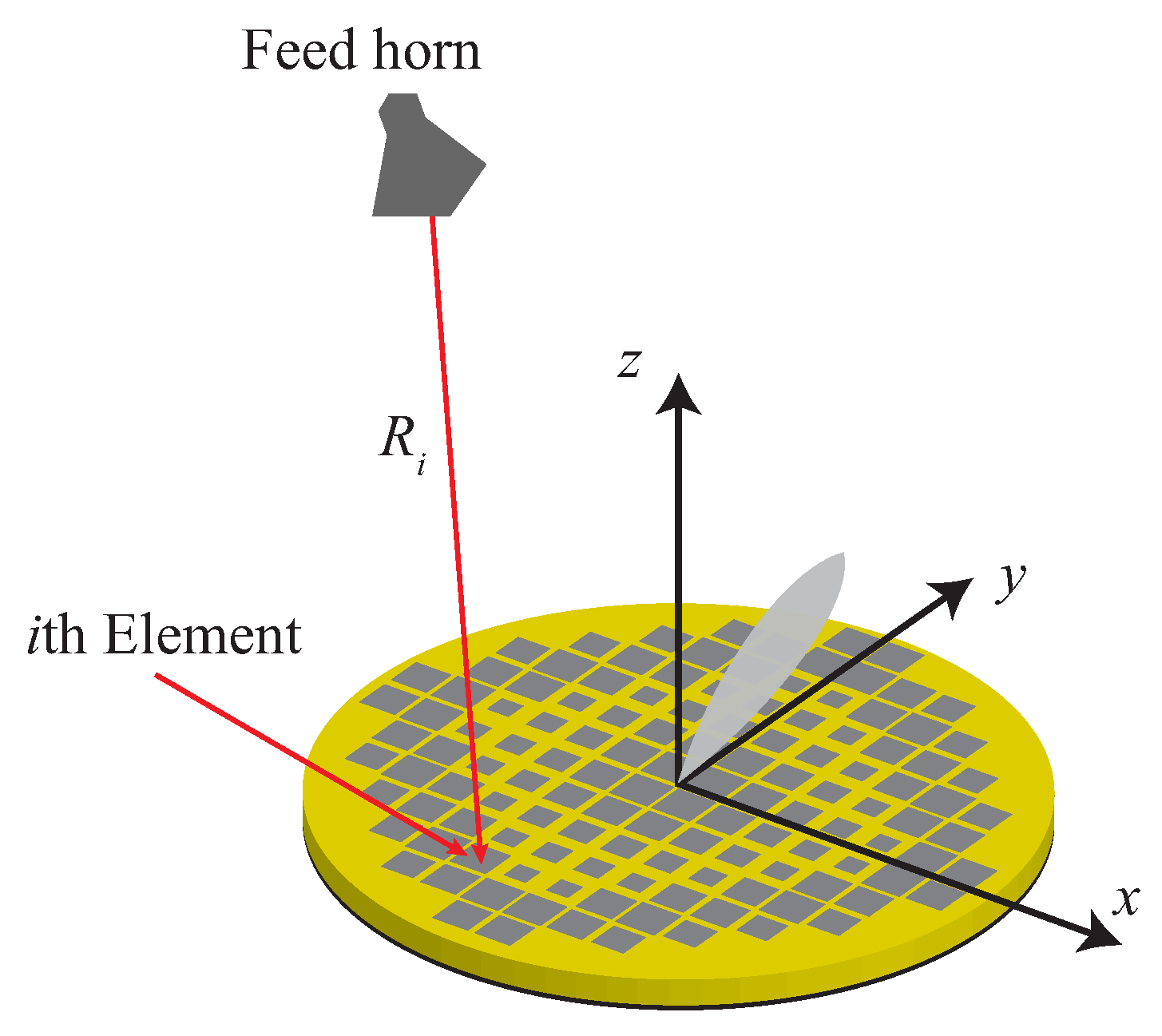
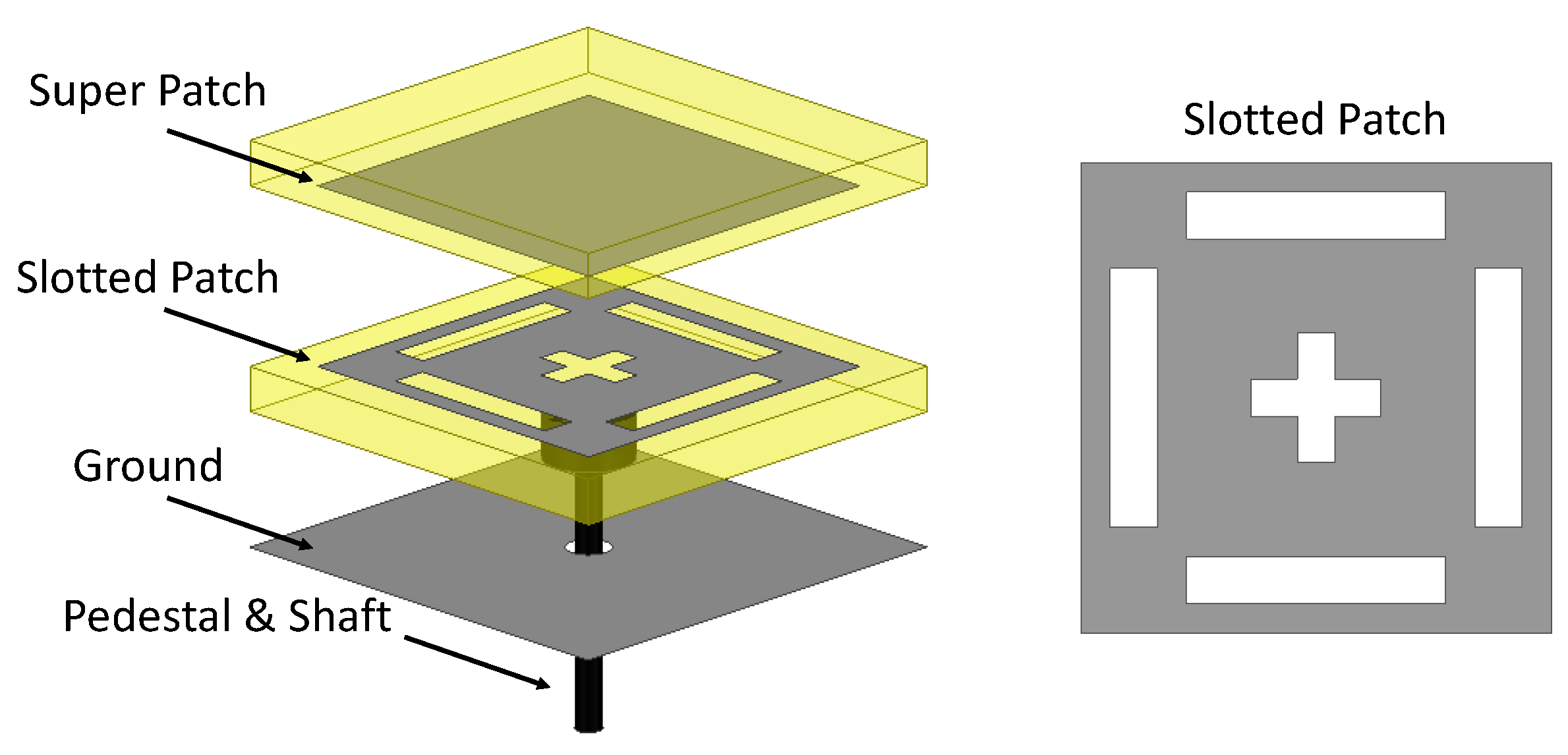

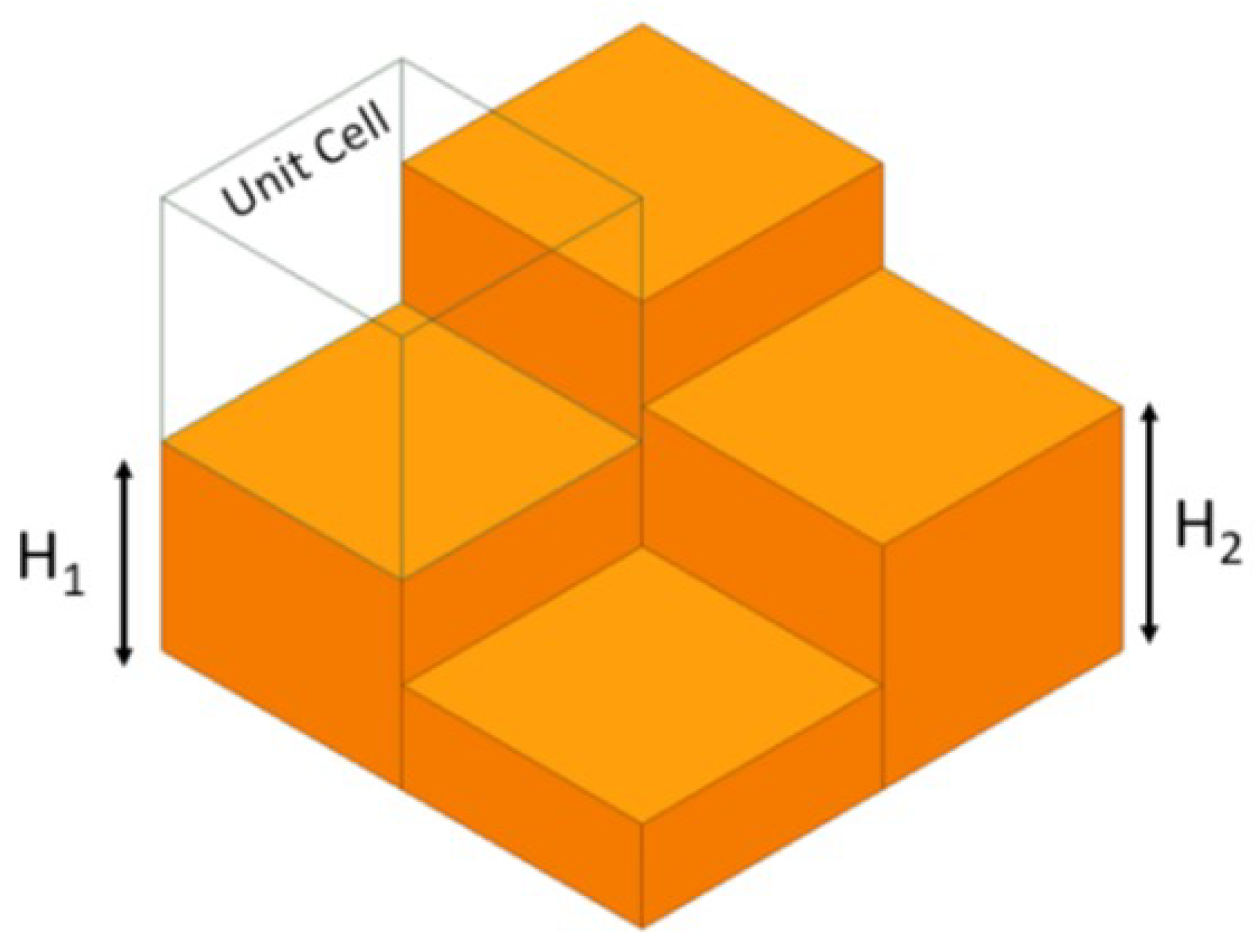

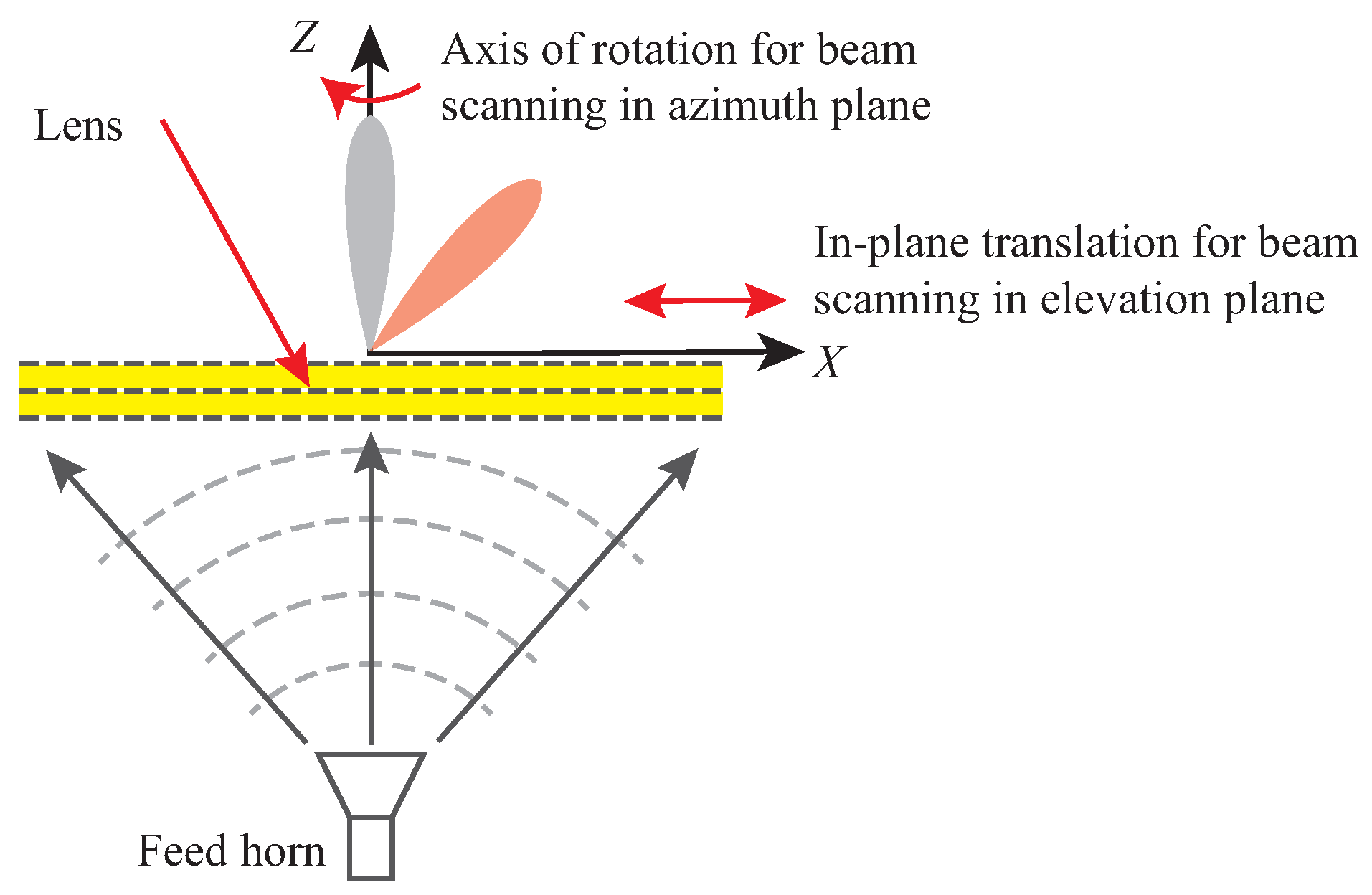


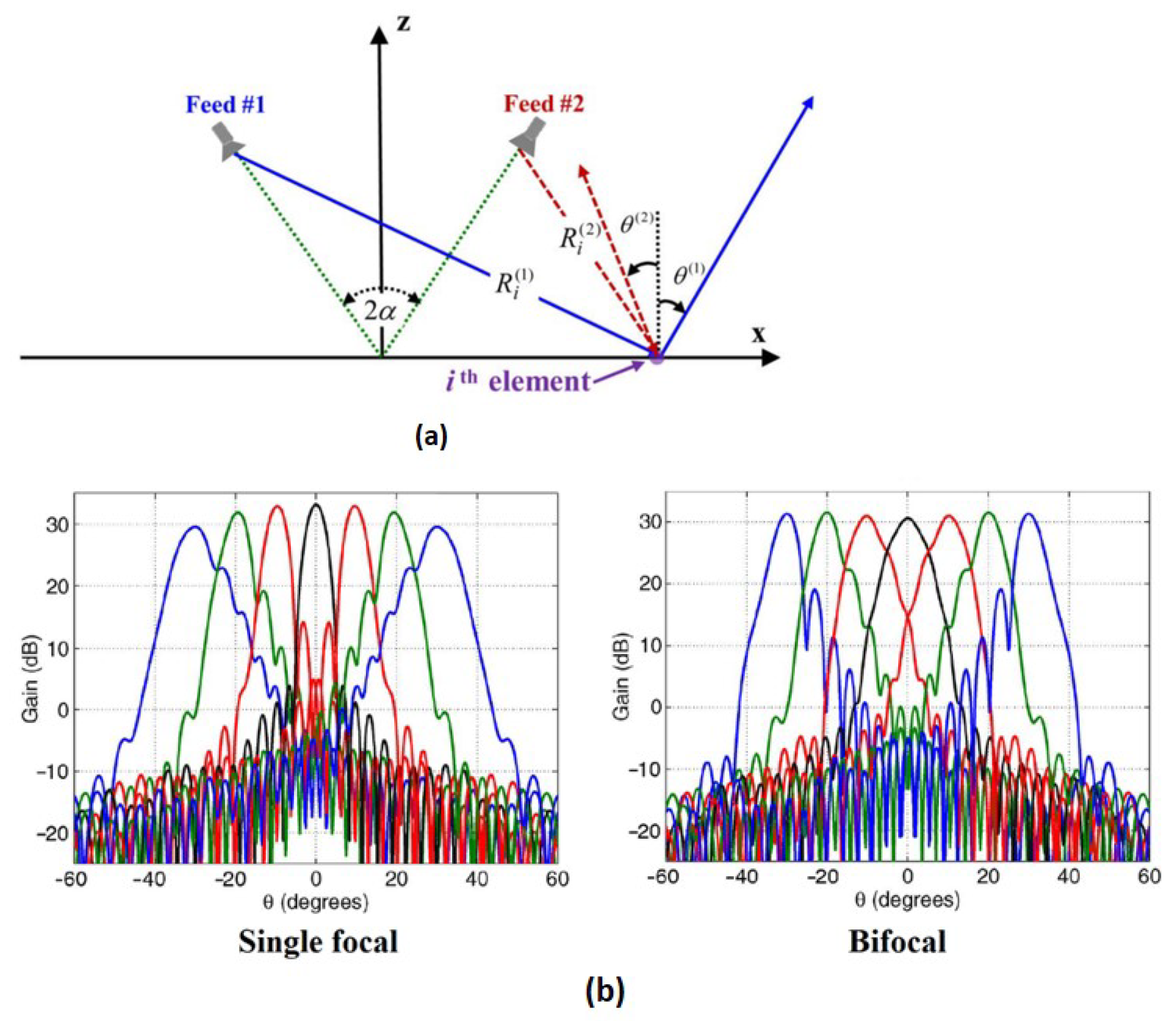
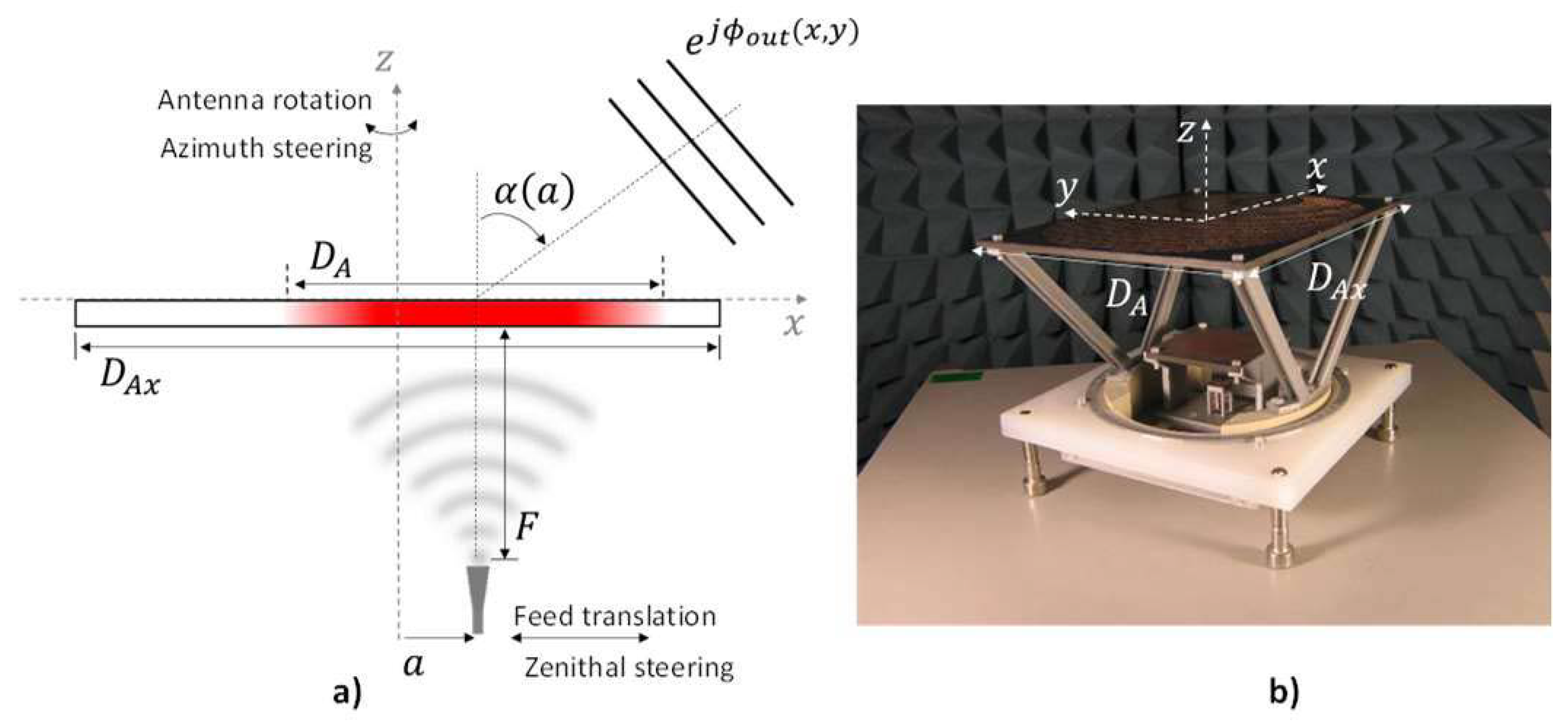
| References | Methodology | Operating Frequency * (GHz)-Bandwidth | 3 dB Beam Scanning Range | Aperture Efficiency |
|---|---|---|---|---|
| [9] | Resonant elements—dimensions adjustment | 4.7–4.9, (4.7%) | 48.6% | |
| [4] | Resonant elements—rotating elements | 7.5–9, (17%) | 51.8% | |
| [13] | Non-resonant elements | 90–110, (20%) | NA | 50.1% |
| References | Methodology | Operating Frequency (GHz) | Beam Scanning Range | Aperture Efficiency |
|---|---|---|---|---|
| [20] | Risley-prism-based beam-steerable antenna | 30.0 | 21.7% | |
| [23] | Risley-prism-based beam-steerable antenna | 11.0 | 19.2% | |
| [29] | Moving and/or rotating a lens | 30.0 | 20.5 | |
| [37] | Titling the ground plane of RA | 9.5 | NA |
| References | Methodology | Operating Frequency Bandwidth (GHz)-1 dB Gain | 3 dB Beam Scanning Range | Aperture Efficiency |
|---|---|---|---|---|
| [42] | Fully illuminated single focal array-reflectarray | 11.6–12.7 (9.1 %) | 43.1% | |
| [58] | Fully illuminated single focal array-transmitarray | NA | 24.5% | |
| [49] | Fully illuminated multifocal array-reflectarray | 31.6–33.2 (4.75 %) | 40% | |
| [56] | Partially illuminated array-reflectarray | NA | 4.7% |
| Method | Scanning Capabilities | Frequency Bandwidth | Cost and Complexity | Power Consumption |
|---|---|---|---|---|
| Element Movement | ✓ | ✓ | ✕ | ✕ |
| Array Movement | — | — | ✓ | — |
| Feed Movement | — | — | ✓ | ✓ |
Publisher’s Note: MDPI stays neutral with regard to jurisdictional claims in published maps and institutional affiliations. |
© 2021 by the authors. Licensee MDPI, Basel, Switzerland. This article is an open access article distributed under the terms and conditions of the Creative Commons Attribution (CC BY) license (https://creativecommons.org/licenses/by/4.0/).
Share and Cite
Mirmozafari, M.; Zhang, Z.; Gao, M.; Zhao, J.; Honari, M.M.; Booske, J.H.; Behdad, N. Mechanically Reconfigurable, Beam-Scanning Reflectarray and Transmitarray Antennas: A Review. Appl. Sci. 2021, 11, 6890. https://doi.org/10.3390/app11156890
Mirmozafari M, Zhang Z, Gao M, Zhao J, Honari MM, Booske JH, Behdad N. Mechanically Reconfigurable, Beam-Scanning Reflectarray and Transmitarray Antennas: A Review. Applied Sciences. 2021; 11(15):6890. https://doi.org/10.3390/app11156890
Chicago/Turabian StyleMirmozafari, Mirhamed, Zongtang Zhang, Meng Gao, Jiahao Zhao, Mohammad Mahdi Honari, John H. Booske, and Nader Behdad. 2021. "Mechanically Reconfigurable, Beam-Scanning Reflectarray and Transmitarray Antennas: A Review" Applied Sciences 11, no. 15: 6890. https://doi.org/10.3390/app11156890
APA StyleMirmozafari, M., Zhang, Z., Gao, M., Zhao, J., Honari, M. M., Booske, J. H., & Behdad, N. (2021). Mechanically Reconfigurable, Beam-Scanning Reflectarray and Transmitarray Antennas: A Review. Applied Sciences, 11(15), 6890. https://doi.org/10.3390/app11156890





